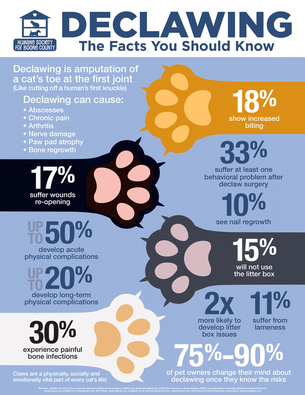RESOURCES
Declawing Information
 Click to enlarge.
Click to enlarge.
The Humane Society for Boone County abides by the American Association of Feline Practitioners policy on cat declawing which states:
The American Association of Feline Practitioners (AAFP) strongly opposes declawing (onychectomy) as an elective procedure. It is the obligation of veterinarians to provide cat owners with alternatives
to declawing. If owners are considering declawing, they must be provided with complete education
about feline declawing.
The following points are the foundation of the position statement:
Links to scratching resources for kitties: www.catvets.com/content/scratching-resource
The American Association of Feline Practitioners (AAFP) strongly opposes declawing (onychectomy) as an elective procedure. It is the obligation of veterinarians to provide cat owners with alternatives
to declawing. If owners are considering declawing, they must be provided with complete education
about feline declawing.
The following points are the foundation of the position statement:
- Feline declawing is an ethically controversial procedure.
- Declawing is NOT a medically necessary procedure for cats in most instances.
- Scratching is a normal feline behavior--both inherited and learned. Cat owners should be educated on feline scratching behaviors. Veterinarians should provide behavioral recommendations that allow cats to express these behaviors and reduce those undesirable to the client.
- Declawing is an amputation of the third phalanx (P3).
- It is the veterinarian’s obligation to educate cat owners and provide them with alternatives to declawing.
- Veterinarians should counsel cat owners on alternatives for declawing such as:
- Providing cats with scratching posts/pads
- Regularly trimming the claws to prevent injury or damage to household items
- Considering temporary synthetic nail caps
- Using synthetic facial pheromone sprays and/or diffusers to help relieve anxiety or stress
- Providing appropriate feline environmental enrichment
- There are inherent risks and complications with declawing that increase with age such as acute pain, infection, nerve trauma, as well as long term complications like lameness, behavioral problems, and chronic neuropathic pain.
Links to scratching resources for kitties: www.catvets.com/content/scratching-resource

